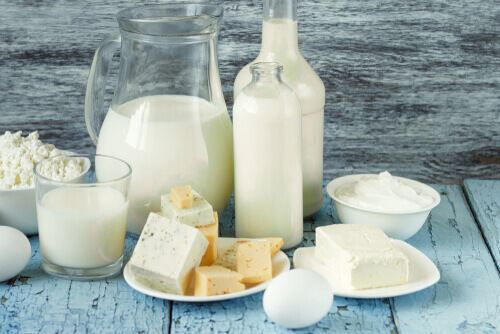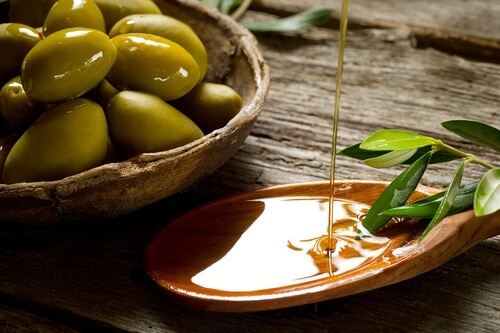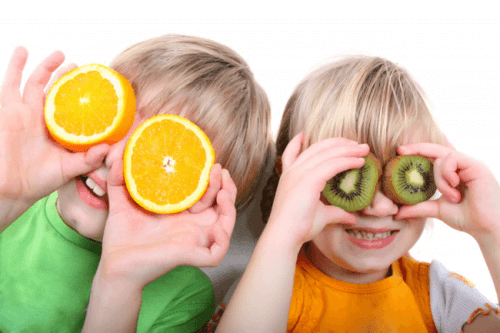8 Vitamin-rich Foods for Children

If you’re concerned about incorporating all of the vitamins that your little one needs in their diet, check out the following list of vitamin-rich foods. Are these ingredients part of your child’s daily diet?
Food is a central aspect necessary for optimal physical, mental and emotional development. During childhood, a stage that is full of maturation and growth, it’s important to have the basic nutrients.
That’s why we decided to provide a list of foods that are rich in vitamins.
Vitamins are necessary for the human body. In this article, we’ll review the different kinds of vitamins and their important functions. We’ll also mention foods that contain specific vitamins.
Why are vitamins important for children?
There are many different kinds of vitamins. For example, there are fat-soluble vitamins such as A, D, E and K which are absorbed with fats. There are also water-soluble vitamins which are B and C which are absorbed best with water.
8 vitamin-rich foods for children
The main way to incorporate vitamins is through a healthy diet. However, there are also vitamin supplements that are available. The following are the ideal foods to incorporate important vitamins into your child’s diet:
-
Vegetables
Although some children aren’t big fans, vegetables are an indispensable source of vitamins. Carrots provide vitamin A, as do leafy greens such as lettuce, spinach and Swiss chard.
Green leafy vegetables also provide vitamin K and B2. Onions, peppers, cabbage and zucchini are all vitamin-rich vegetables.
-
Dairy and eggs
Like carrots and other vegetables with orange pigmentation, dairy products and eggs provide vitamin A. Vitamin A provides many positive benefits for the body.
It contributes to the health of mucus membranes and skin. It also prevents infections and is important for bone development.
Dairy products and eggs also contain vitamin D. Vitamin D is important for calcium absorption. As a result, it works towards healthy bones and teeth.

-
Fish
Fish is very nutritious. In addition to its nutritional value, it’s attractive to children due to its texture, aroma and taste which is quite different from other meats. Some children however, reject fish completely.
-
Cereals
Cereals and legumes contain a lot of vitamin B. Many products that are specifically made for a child’s breakfast are enriched with this vitamin. Vitamin B is best absorbed alongside lactose.
That’s why it’s recommended to combine them with a glass of milk or yogurt at the start of the day.
Vitamin B is very important – it provides energy and is key to their growth. In addition, it also fulfills other important functions that will be explained below.
-
Meat
Not only does meat provide protein, it also provides vitamin B. As we previously mentioned, vitamin B has various functions.
In addition, it’s responsible for collaborating with the functioning of the nervous, digestive and circulatory systems.
“During childhood, a stage that is full of maturation and growth, it’s important to have the basic nutrients.”

-
Olive oil
This is another vitamin-rich food for children due to the fact that it provides vitamin E.
Vitamin E works as an antioxidant and it’s also important for the maintenance of the body’s cells. Adequate amounts of vitamin E are important for disease prevention.
-
Citrus
Citrus made the list of vitamin-rich foods for children because they contribute nutrients that are important for the body’s defenses.
They provide the body with vitamin C. Vitamin C can also be found in kiwis, pineapple, tomatoes and peppers.
Vitamin C is also found in nuts and it’s absorbed easily when combined with iron. That’s why it’s recommended to eat meat or fish combined with a salad of some sort. You can also combine meat meals with a fruit dessert.

-
Avocados
This is another fruit with high nutritional value. Avocado contains both Vitamin E and D.
If you incorporate these vitamin-rich foods into your child’s diet, they’ll cover a large part of their metabolic needs.
Planning meals consciously will result in good health for the little ones and all the other members of the family.
If you’re concerned about incorporating all of the vitamins that your little one needs in their diet, check out the following list of vitamin-rich foods. Are these ingredients part of your child’s daily diet?
Food is a central aspect necessary for optimal physical, mental and emotional development. During childhood, a stage that is full of maturation and growth, it’s important to have the basic nutrients.
That’s why we decided to provide a list of foods that are rich in vitamins.
Vitamins are necessary for the human body. In this article, we’ll review the different kinds of vitamins and their important functions. We’ll also mention foods that contain specific vitamins.
Why are vitamins important for children?
There are many different kinds of vitamins. For example, there are fat-soluble vitamins such as A, D, E and K which are absorbed with fats. There are also water-soluble vitamins which are B and C which are absorbed best with water.
8 vitamin-rich foods for children
The main way to incorporate vitamins is through a healthy diet. However, there are also vitamin supplements that are available. The following are the ideal foods to incorporate important vitamins into your child’s diet:
-
Vegetables
Although some children aren’t big fans, vegetables are an indispensable source of vitamins. Carrots provide vitamin A, as do leafy greens such as lettuce, spinach and Swiss chard.
Green leafy vegetables also provide vitamin K and B2. Onions, peppers, cabbage and zucchini are all vitamin-rich vegetables.
-
Dairy and eggs
Like carrots and other vegetables with orange pigmentation, dairy products and eggs provide vitamin A. Vitamin A provides many positive benefits for the body.
It contributes to the health of mucus membranes and skin. It also prevents infections and is important for bone development.
Dairy products and eggs also contain vitamin D. Vitamin D is important for calcium absorption. As a result, it works towards healthy bones and teeth.

-
Fish
Fish is very nutritious. In addition to its nutritional value, it’s attractive to children due to its texture, aroma and taste which is quite different from other meats. Some children however, reject fish completely.
-
Cereals
Cereals and legumes contain a lot of vitamin B. Many products that are specifically made for a child’s breakfast are enriched with this vitamin. Vitamin B is best absorbed alongside lactose.
That’s why it’s recommended to combine them with a glass of milk or yogurt at the start of the day.
Vitamin B is very important – it provides energy and is key to their growth. In addition, it also fulfills other important functions that will be explained below.
-
Meat
Not only does meat provide protein, it also provides vitamin B. As we previously mentioned, vitamin B has various functions.
In addition, it’s responsible for collaborating with the functioning of the nervous, digestive and circulatory systems.
“During childhood, a stage that is full of maturation and growth, it’s important to have the basic nutrients.”

-
Olive oil
This is another vitamin-rich food for children due to the fact that it provides vitamin E.
Vitamin E works as an antioxidant and it’s also important for the maintenance of the body’s cells. Adequate amounts of vitamin E are important for disease prevention.
-
Citrus
Citrus made the list of vitamin-rich foods for children because they contribute nutrients that are important for the body’s defenses.
They provide the body with vitamin C. Vitamin C can also be found in kiwis, pineapple, tomatoes and peppers.
Vitamin C is also found in nuts and it’s absorbed easily when combined with iron. That’s why it’s recommended to eat meat or fish combined with a salad of some sort. You can also combine meat meals with a fruit dessert.

-
Avocados
This is another fruit with high nutritional value. Avocado contains both Vitamin E and D.
If you incorporate these vitamin-rich foods into your child’s diet, they’ll cover a large part of their metabolic needs.
Planning meals consciously will result in good health for the little ones and all the other members of the family.
All cited sources were thoroughly reviewed by our team to ensure their quality, reliability, currency, and validity. The bibliography of this article was considered reliable and of academic or scientific accuracy.
- Biesalski H., Tinz J., Multivitamin/mineral supplements: rationale and safety. Nutrition, 2017.
- Office of Dietary Supplements. Vitamin C. U. S. Department of Health and Human Services. Marzo 2021.
- Office of Dietary Supplements. Vitamin E. U. S. Department of Health and Human Services. Marzo 2021.
- U. S. Department of Agriculture and U. S. Department of Health and Human Services. Dietary Guidelines for Americans 2020-2025. 9th Edition. Diciembre 2020.
- USDA My Plate. Dairy. U. S. Department of Agriculture.
- Wang TJ., Vitamin D and cardiovascular disease. Annu Rev Med, 2016.
This text is provided for informational purposes only and does not replace consultation with a professional. If in doubt, consult your specialist.








